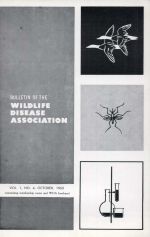It had been previously observed that large doses of a highly virulent, avian isolate of the psittacosis-LGV-trachoma (PLT) group of organisms originally recovered from turkeys failed to affect pigeons and sparrows while readily producing lethal infections in a variety of other birds and mammals (Page, 1965). On the suspicion that the unusually high normal body temperature (43 ± 0.5°C) of pigeons and sparrows might be a factor in the resistance of these birds to this PLT isolate, the in vitro rates of inactivation at 43 °C of the organisms infectivity for chicken embryos and the toxicity for mice were determined in comparison with an isolate of a strain normally found in pigeons and which causes disease in pigeons and sparrows. Growth rates of both isolates at 43 °C in cultures of mebryonic chicken tissues were also compared.
The turkey isolate was inactivated in vitro at a consistently rapid rate at 43 °C while the pigeon isolate was relatively resistant to 43 °C inactivation. Both isolates failed to multiply in primary, embryonic chicken fibroblasts at this temperature, therefore titration of the infectivity of tissue culture homogenates at intervals after inoculation resulted only in obtaining more thermostability data. In another test, the “toxin” or mouse lethality factor possessed by the turkey isolate was slowly inactivated at 43 °C whereas the “toxin” of the pigeon isolate appeared to increase for the period of the test. Lastly, a suspension of the pigeon isolate which had been heated for 24 hours at 43 °C remained infectious for both pigeons and sparrows whereas the turkey isolate failed to affect either species whether or not the isolate was heated. These results suggested that because of its 43 °C sensitivity, the turkey isolate was less able to survive and cause disease in birds whose normal temperature was 43 °C than was the pigeon isolate.





